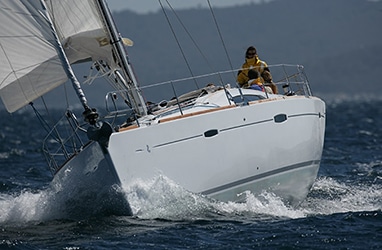
This article is an excerpt from NauticEd’s online FREE Navigation Rules Course, an interactive online sailing course for ALL sailors to learn Navigation Rules and become a safer sailor. Or if you want to learn more, upgrade to the Skipper Course Bundle to become a competent sailor!
You can learn to sail and improve your sailing with NauticEd, the international leader in sailing education.
Seamanship Nav Rules
As we go through these rules we shall often state the rule and give a discussion summary thereof. Don’t take the discussion as 100% gospel of the rules. The rules are the rules our discussion is some general guideline to help (there we just covered ourselves legally).
Rule 2: Responsibility
The Rule
(a) Nothing in these Rules shall exonerate any vessel, or the owner, master, or crew thereof, from the consequences of any neglect to comply with these Rules or of the neglect of any precaution which may be required by the ordinary practice of seamen, or by the special circumstances of the case.
(b) In construing and complying with these Rules due regard shall be had to all dangers of navigation and collision and to any special circumstances, including the limitations of the vessels involved, which may make a departure from these Rules necessary to avoid immediate danger.
Discussion
The rules refer many times to good seamanship. This is a good catch-all so that a judge can make a decision around “Was the vessel master who appeared to have Stand-On rights, still acting with common sense?”. This question means a decision can go anyway and will probably eventually be argued out in reality with the side that pays the most money to a team of lawyers. As bad and poor a statement about society as that is – it is just reality – get over it. In an idealistic world, the Judges would filter out the $ and make a sound decision, but that is not necessarily reality either.
Good seamanship comes from experience and it is for this reason that operating as the master of large commercial ships requires years of experience. BUT the same seamanship rule is applied all the way down to a kayak because Rule 1(a) says these rules apply to all vessels.
Operating without good seamanship even though you were the Stand-On vessel could result in you being liable for the accident. As you read through the rules below it will become apparent that perhaps this is a surprisingly and unexpected fair statement.
The best advice we can give here around seamanship is to get experience. If you have never been on a boat before, it’s probably not a good idea to buy one outright and operate as the master. Gain lots of crewing experience. If you’re just getting started in sailing, go join your local yacht club and crew in regattas. This will be your fastest learning curve.
Learn Navigation Rules for Free...
A FREE 3-hour course that teaches how to stay safe, avoid collisions and accidents, and learn the “Rules of the Road”. The free Navigation Rules Course is for ALL sailors, whether you’re just learning or need a FREE refresher. Or, consider upgrading to the Skipper Course Bundle to become a fully competent skipper!
